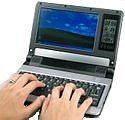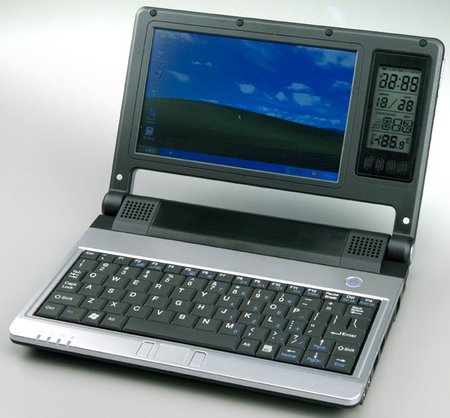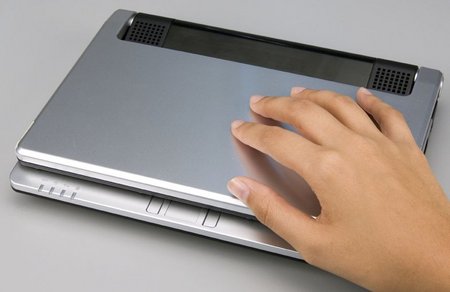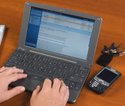Via unveils “ultra mobile device” reference design
Jun 5, 2007 — by LinuxDevices Staff — from the LinuxDevices Archive — 10 views Via Technologies on June 6 unveiled the NanoBook Ultra Mobile Device (UMD) reference design — a UMPC-like device, but with a full QWERTY keyboard. The “sub-notebook” style design aims to enable device-makers to build customized low-cost, light-weight mobile PCs for consumers, businesses, and schools, Via said.
Via Technologies on June 6 unveiled the NanoBook Ultra Mobile Device (UMD) reference design — a UMPC-like device, but with a full QWERTY keyboard. The “sub-notebook” style design aims to enable device-makers to build customized low-cost, light-weight mobile PCs for consumers, businesses, and schools, Via said.
(Click for larger view of the NanoBook UMD)
digg this story |
Unveiled at the annual Via Technology Forum in Taipei, Taiwan, the NanoBook design is based on Via's C7-M Ultra Mobile Platform chipset, which includes a 1.2GHz Via C7-M ULV Processor. The design packs a 7-inch WVGA (840 x 480 pixel) touchscreen LCD, a full-size, standard QWERTY keyboard, a 30GB or 60GB hard drive, and stereo speakers. It also includes up to 1GB DDR2 SDRAM, a 4-in-1 card reader, 802.11b/g and Bluetooth wireless, Ethernet, DVI video output, and two USB 2.0 ports.
One unique feature of the NanoBook is a USB-connected module dock to the right of the main display. A fingernail latch on the edge of the display lid lets users swap various “MobilityPLUS” modules into the bay. Available modules will apparently include a World Time Clock, GPS receiver, DVB (digital video broadcast) receiver, VoIP (voice-over-IP) phone, and 3G/CDMA wireless broadband modules.

Via's NanoBook UMD targets consumers, businesses, and schools
(Click to enlarge)
The NanoBook is about the size of a composition notebook, weighs less than two pounds, and is a little over 1-inch thick, Via said. The company claims the device will operate up to 4.5 hours on one charge of its internal four-cell battery pack. Supported operating systems, according to Via, include “all popular Linux distributions,” as well as Windows XP and Vista.

The NanoBook is about the size of a typical UMPC
(Click to enlarge)
 Palm Foleo (Click for details) |
The NanoBook UMD bears an interesting resemblance to Palm's Foleo “mobile companion,” revealed last week. Compared to the NanoBook, the Foleo has a larger, higher-resolution screen — 10.2-inches with 1024×600 or 1024×768 (SXGA) resolution — but is limited to flash storage. Rumor has it that the Foleo's processor is an ARM-, rather than x86-based, CPU, constraining it to run Linux-based internal application software. While Palm's Foleo is not being promoted as a full-function UMPC — Via's NanoBook offers extensive sub-notebook PC style capabilities. Both devices claim four to five hours of battery life per recharge, although the Foleo would appear to have the upper hand in that department, due to reduced processor bandwidth and the lack of a hard drive.
NanoBook specs
Key specifications of the NanoBook UMD platform, according to Via, include:
- Processor — 1.2GHz Via C7-M ULV Processor
- Chipset — Via VX700 System Media Processor with integrated North and South Bridge
- Memory — DDR2 SO-DIMM up to 1GB
- Storage — built-in 30GB or 60GB hard drive
- Graphics:
- Based on Via UniChrome Pro II IGP Integrated 3D/2D Graphics
- uses shared video memory up to 64MB
- DVI-I port
- built-in 7-inch WVGA (840 x 480 pixel) LCD with touchscreen
- Audio:
- based on Via Vinyl VT1708A HD Audio codec
- built-in stereo speakers
- mic in, array mic jack, 1 headphone/line out jack
- Wired/wireless networking:
- Ethernet — 10/100 Mbps, based on Realtek RTL8100CL
- WiFi — 802.11b/g, based on Azure Wave (USB interfaced)
- Bluetooth — based on Billionton (USB interfaced)
- 4-in-1 card reader
- 2 x USB 2.0 ports
- Battery — 4 rechargeable cells, for up to 4.5 hours of battery life
- Dimensions — 9.1 x 6.7 x 1.2 inches (230 x 171 x 29.4mm)
- Weight — under 2 pounds (850g)
Via's C7-M Ultra Mobile Platform chipset draws less power than other chipsets, the manufacturer says, because it is based on an ultra-low-voltage processor, and is built with IBM's 90nm SOI chip-making process that places a layer of insulation between silicon substrates — the same chip technology used in latest-generation video game consoles such as the Xbox 360 and Wii.
Optional accessories, according to Via, include MobilityPLUS modules; Bluetooth VoIP phone; GPS; DVB; 3G/CDMA phone; world clock; a DVI-to-CRT transfer cable; a car adapter; and a leather cover.
A Via-produced video showing Marketing VP Rich Brown toting a Nanobook on a tour of Beat Poet hangouts in San Francisco's North Beach district can be found here. Ironically, given the NanoBook's fullsize keyboard, Brown appears to be a hunt-and-peck typist.
Availability
OEM (original equipment manufacturer) availability of the NanoBook UMD reference design is scheduled for the second half of 2007, Via said.
Via said that its NanoBook UMD Reference Design has already been adopted by Packard Bell, a leading European PC brand, as the basis for a forthcoming EasyNote XS product.
The NanoBook UMD platform is expected to spawn devices that reach market in the U.S. at around a $600 price point, according to Via VP of marketing Richard Brown.
This article was originally published on LinuxDevices.com and has been donated to the open source community by QuinStreet Inc. Please visit LinuxToday.com for up-to-date news and articles about Linux and open source.